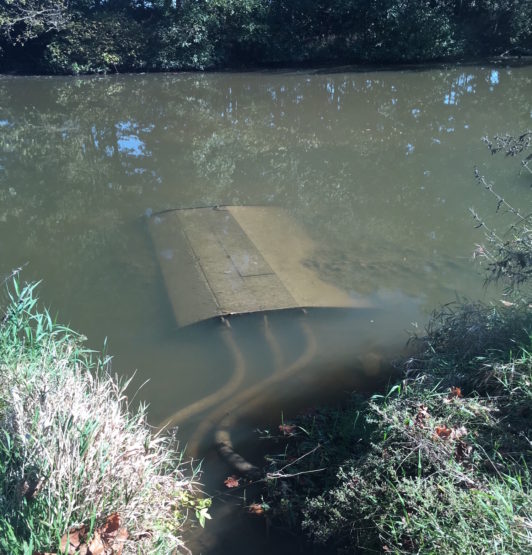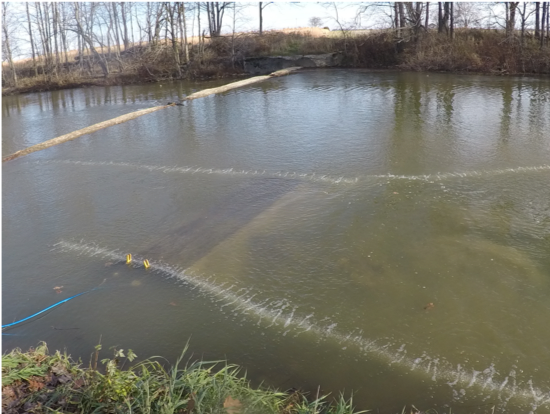Blanchard River – Bedload Interception – Silt Collector
The Silt Collector is a model of the Bedload Sediment Collector, developed by Streamside Technology LLC, that is installed at the bottom of a river or stream and uses a specialized internal bubbler tube to create a barrier wall for the suspended sediments to also be captured in the collector hopper. This latest collector series for Streamside provides multiple benefits including sediment removal, suspended sediment reduction, nutrient reduction, and water quality improvement all in one system.
Blanchard River Silt Collector Project – Findlay, OH
The Silt Collector was installed just upstream of the low-head dam at the pump station for the #1 Reservoir on the Blanchard River south east of Findlay. The City of Findlay played an integral part into the project by providing equipment for installation and removal of the equipment, secure building storage of the air compressor for the bubblers and providing the electrical power for the duration of the project.
A team from Heidelberg University in Tiffin, OH installed instrumentation in the river to provide monitoring and data collection for the duration of the project. Once all equipment and instruments were set, the system was then turned on and operated from a control panel on the shore. The material captured in the Silt Collector was pump through a submersible pump installed in the stream bank and discharged to upland settling tanks. The settling tanks allowed for the fine silts and organics to “fall out” of suspension in the first tank with overflow into the second and third providing additional settling and the water was then pumped back into the Silt Collector.
After going thru the data, certain things stood out. The bubble curtain did provide the ability to capture and remove turbidity (suspended sediments) along with organic particles during lower and normal flows, but as the flows increased during storm events the bubbles lost efficiency.
The Bubble Curtain during normal river flows removed an average of 25% of the turbidity plus substantial amount of small organic mass and silts. We are still waiting for the laboratory test results on the composition of the collected material. I would presume that we will find significant Phosphorus and Nitrates attached to these samples.
This Silt Collector is advanced and unique for Streamside, where it has proven the capability (when paired with the bubbler system) of removing both suspended and bedload sediment at its natural transport rate.
The Silt Collector is a model of the Bedload Sediment Collector, developed by Streamside Technology LLC, that is installed at the bottom of a river or stream and uses a specialized internal bubbler tube to create a barrier wall for the suspended sediments to also be captured in the collector hopper. This latest collector series for Streamside provides multiple benefits including sediment removal, suspended sediment reduction, nutrient reduction, and water quality improvement all in one system.
Blanchard River Silt Collector Project – Findlay, OH
The Silt Collector was installed just upstream of the low-head dam at the pump station for the #1 Reservoir on the Blanchard River south east of Findlay. The City of Findlay played an integral part into the project by providing equipment for installation and removal of the equipment, secure building storage of the air compressor for the bubblers and providing the electrical power for the duration of the project.
A team from Heidelberg University in Tiffin, OH installed instrumentation in the river to provide monitoring and data collection for the duration of the project. Once all equipment and instruments were set, the system was then turned on and operated from a control panel on the shore. The material captured in the Silt Collector was pump through a submersible pump installed in the stream bank and discharged to upland settling tanks. The settling tanks allowed for the fine silts and organics to “fall out” of suspension in the first tank with overflow into the second and third providing additional settling and the water was then pumped back into the Silt Collector.
After going thru the data, certain things stood out. The bubble curtain did provide the ability to capture and remove turbidity (suspended sediments) along with organic particles during lower and normal flows, but as the flows increased during storm events the bubbles lost efficiency.
The Bubble Curtain during normal river flows removed an average of 25% of the turbidity plus substantial amount of small organic mass and silts. We are still waiting for the laboratory test results on the composition of the collected material. I would presume that we will find significant Phosphorus and Nitrates attached to these samples.
This Silt Collector is advanced and unique for Streamside, where it has proven the capability (when paired with the bubbler system) of removing both suspended and bedload sediment at its natural transport rate.


